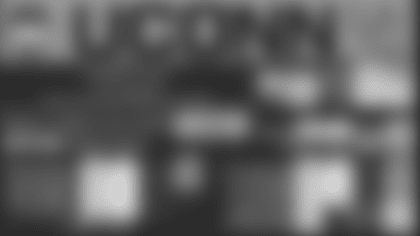This is the fourth in our series of articles taking a deeper dive with the use of data and game film into the Giants' 2020 draft class. We have already studied Andrew Thomas, Xavier McKinney and Shane Lemieux. Here is a look at third round pick Matt Peart, who was selected 99th overall with a compensatory pick at the end of the third round.
Athletic Traits
I like to use two different metrics when evaluating a player's measureables. The first is RAS, which stands for Relative Athletic Score. It is a formula created by Kent Lee Platte and compares a player's measurements and testing during the pre-draft process to everyone else at the position that has been tested since 1987. A 10 is the highest score with 5 being a true average score. You can find all the class's RAS scores at relativeathleticscores.com.

The other useful illustration are the spider graphs posted at mockdraftable.com, which provides a nice visual of what a player's strengths are compared to others at the position. The numbers represent the percentile each player ranks in each category relative to the other players at his position.
Peart performed at the very top of the combine class, finishing in the 90th percentile of players at offensive tackle dating back to 1987. He had the fifth best composite RAS performance of offensive tackles at the 2020 NFL Combine, trailing only Ezra Cleveland, Mekhi Becton, Tristan Wirfs and Austin Jackson.
His reach, the longest at the combine at 36 5/8-inch, is his most impressive physical characteristic. He has excellent height at 6-6, but as Dave Gettleman and Joe Judge mentioned during the draft, he has a frame that will bulk up in an NFL weight room.
His broad jump, a measure of explosion, was excellent, and his vertical jump was only slightly less so. His 40 time of 5.06 seconds was very good for the offensive tackle group, and his 10-yard split of 1.75 seconds was even better. He has the type of explosion and straight ahead athleticism teams look for in offensive tackles.
In the agility drills, his three-cone time (8.01 seconds) and short shuttle time (2.41 seconds) ranked below the 30th percentile. These types of events tend to measure the ability to move side to side and quickly change direction.
College History (Advanced Production Numbers Courtesy of Pro Football Focus)
2016: True Freshman Season – 12 Starts at right tackle
PFF Numbers: 512 pass blocking snaps, 1 sack, 3 QB hits and 19 QB hurries allowed
2017: Sophomore Season – 12 starts at left tackle
PFF Numbers: 532 pass blocking snaps, 4 sacks, 1 QB hits and 14 QB hurries allowed
2018: Junior Season – 12 starts at right tackle
PFF Numbers: 424 pass blocking snaps, 2 sack, 5 QB hits, and 15 QB hurries allowed
2019: Senior Season – 12 starts at right tackle – First Team All-AAC – Team Captain
PFF Numbers: 415 pass blocking snaps, 2 sacks, 1 QB hit, and 4 QB Hurries allowed
Overall: 96th on PFF's big board.
Injuries: Missed no games due to injury in college
Athletic Background: Born in Jamaica, Peart's family moved family to New York City in 2002. He grew up playing soccer but switched to basketball in high school and was team captain. He also participated in track and lacrosse in high school. He did not play varsity football until his junior year when he played defensive end. He did not play offensive tackle until his senior year, an indication he has more room to grow with his technique.
Film Study
Peart has a lot of good tape from his days at the University of Connecticut.
He pulls on this run play from his right tackle spot, then meets and forces the linebacker out of the hole to clear space for a big run. Peart's movement skills are easy to see here as he smoothly pulls into the hole all the way to the left side of the line.
Peart starts in a three-point stance at right tackle and keeps his feet moving to lead the way on an outside zone run.
On this play, Peart is part of a double team before continuing to stay engaged and move the defensive tackle all the way across the line of scrimmage.
In the pass game, Peart shows the ability to get out of his stance and kick slide into position between his man and the quarterback. Here, the defensive end makes the initial contact into Peart's chest with his hands. Peart then extends his arms and uses his length to get the defender off him before turning him using his strength.
Here is Peart on a screen pass using his athleticism to get out in space and block in the screen game.
UConn ran a lot of play action and bootlegs. The last play is Peart helping inside on a double team block while looking for anyone else coming after the quarterback from his right.
With Nate Solder, Came Fleming, Andrew Thomas and Nick Gates on the roster, Peart has time to get himself accustomed to the NFL game. He has most of the traits scouts look for in offensive tackles. If he can continue to mature physically and improve his technique, he could be a long-time starter at offensive tackle in the NFL.

Sign up for the Giants Newsletter
Breaking news and exclusive content direct to your inbox






